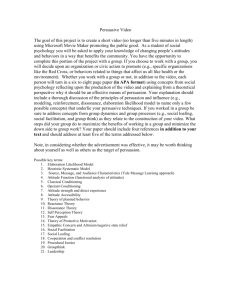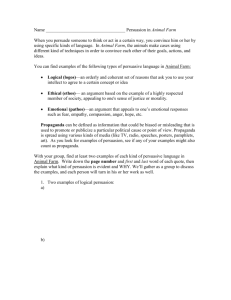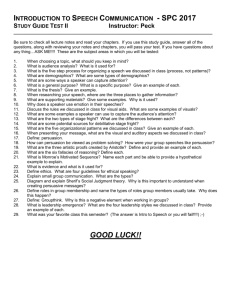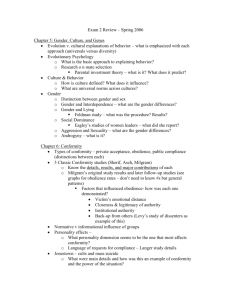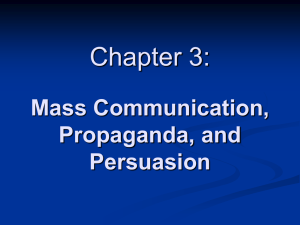chapter 6: persuasion and attitude change
advertisement
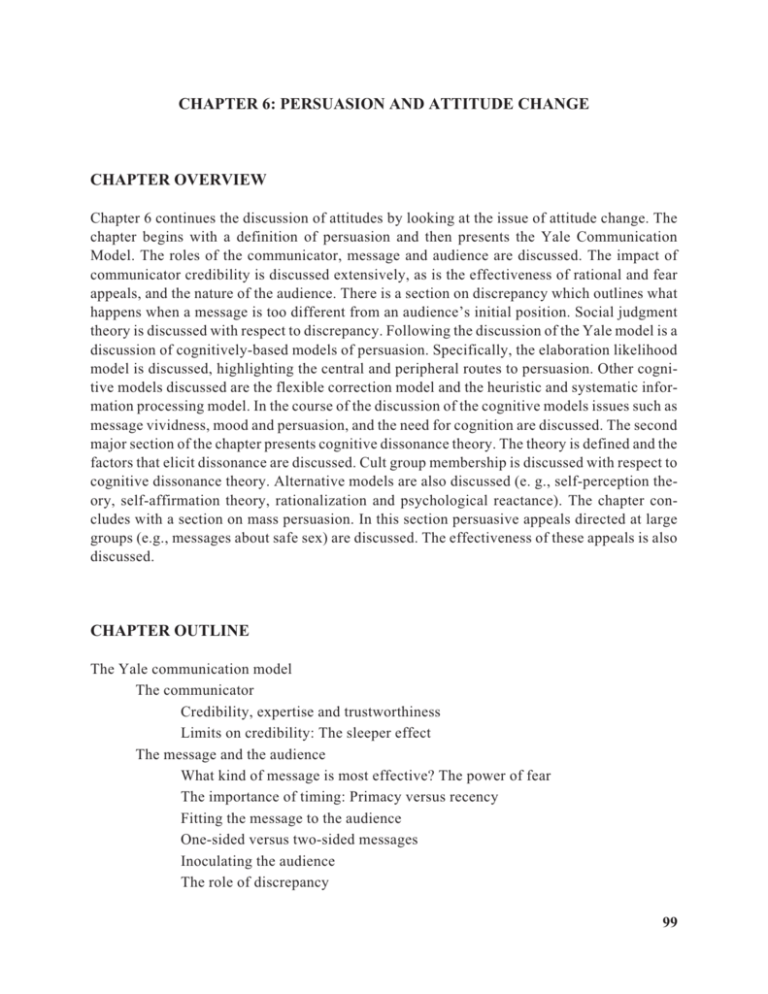
CHAPTER 6: PERSUASION AND ATTITUDE CHANGE CHAPTER OVERVIEW Chapter 6 continues the discussion of attitudes by looking at the issue of attitude change. The chapter begins with a definition of persuasion and then presents the Yale Communication Model. The roles of the communicator, message and audience are discussed. The impact of communicator credibility is discussed extensively, as is the effectiveness of rational and fear appeals, and the nature of the audience. There is a section on discrepancy which outlines what happens when a message is too different from an audience’s initial position. Social judgment theory is discussed with respect to discrepancy. Following the discussion of the Yale model is a discussion of cognitively-based models of persuasion. Specifically, the elaboration likelihood model is discussed, highlighting the central and peripheral routes to persuasion. Other cognitive models discussed are the flexible correction model and the heuristic and systematic information processing model. In the course of the discussion of the cognitive models issues such as message vividness, mood and persuasion, and the need for cognition are discussed. The second major section of the chapter presents cognitive dissonance theory. The theory is defined and the factors that elicit dissonance are discussed. Cult group membership is discussed with respect to cognitive dissonance theory. Alternative models are also discussed (e. g., self-perception theory, self-affirmation theory, rationalization and psychological reactance). The chapter concludes with a section on mass persuasion. In this section persuasive appeals directed at large groups (e.g., messages about safe sex) are discussed. The effectiveness of these appeals is also discussed. CHAPTER OUTLINE The Yale communication model The communicator Credibility, expertise and trustworthiness Limits on credibility: The sleeper effect The message and the audience What kind of message is most effective? The power of fear The importance of timing: Primacy versus recency Fitting the message to the audience One-sided versus two-sided messages Inoculating the audience The role of discrepancy 99 Social judgment theory The problem of multiple audiences The cognitive approach to persuasion The elaboration likelihood model Central route processing Peripheral route processing The effect of mood on processing The effect of personal relevance on processing The impact of attitude accessibility on elaboration Do vivid messages persuade better than nonvivid messages? The need for cognition: Some like it the hard way The heuristic model of persuasion Cognitive dissonance theory: A model of self-persuasion Cognitive dissonance theory How does cognitive dissonance lead to attitude change? The reverse incentive effect The importance of free choice Postdecsion dissonance Responsibility: Another view of cognitive dissonance Attribution processes and dissonance Lessons of cognitive dissonance theory Cognitive dissonance and cult membership Alternatives to cognitive dissonance theory Self-perception theory Rationalization and self-affirmation theory Psychological reactance Persuading the masses Public health campaigns: Educating people about AIDS Changing sexual attitudes and behavior Reaching the adolescent population The limits of persuasion The Leopold and Loeb case revisited Chapter review Internet activity Suggestions for further reading 100 KEY TERMS Persuasion (193) Yale communication model (193) Credibility (194) Expertise (195) Trustworthiness (195) Sleeper effect (196) Latitude of noncommitment (204) Multiple audience problem (205) Elaboration likelihood model (206) Central route processing (206) Heuristic and systematic information processing model (215) Cognitive dissonance theory (216) Postdecision dissonance (218) Self-perception theory (224) Inoculation theory (202) Peripheral route processing (207) Social judgement theory (203) Flexible correction model (210) Psychological reactance (225) Latitude of acceptance (203) Need for cognition (215) Illusion of unique invulnerability (226) Latitude of rejection (204) Self-affirmation theory (224) LEARNING OBJECTIVES At the conclusion of Chapter 6, you should be able to: 1. Compare and contrast the various models of persuasion and discuss how each model addresses different aspects of the persuasion process (e.g., the source, the message, and the audience). You should be familiar with the basic tenets of the Yale communication model, the elaboration likelihood model, and the heuristic/systematic model of persuasion. Further, you should consider the extent to which each model views the audience as playing an active role in the persuasion process. 101 2. Discuss the two routes to persuasion posited by the elaboration likelihood model and tell what factors would lead you to expect an audience to take one route or the other. You should be capable of distinguishing between the central and peripheral routes to persuasion as identified by the elaboration likelihood model and be able to identify the various ability and motivational factors that increase or decrease message elaboration. 3. Discuss the flexible correction model. You should be able to define the flexible correction model and describe the conditions under which correction for biasing factors takes place. 4. Describe and discuss the roles of personal relevance and attitude accessibility in persuasion. You should understand that personal relevance affects whether a message is processed via the central or peripheral route. Central route processing is more likely to occur when a persuasive message is personally relevant. You should also be able to articulate how attitude accessibility relates to the manner in which a message is processed. 5. Discuss some of the approaches to persuasion in the everyday world and answer the question “Are vivid messages more persuasive?” Consider the media’s approach to persuading the public on important issues such as AIDS and smoking. You should also be able to discuss the persuasion techniques politicians use to boost their own credibility and destroy the credibility of their opponents. 6. Define and discuss the major points of cognitive dissonance theory. Here you understand that when cognitions and behaviors are inconsistent we experience a negative motivational state known as cognitive dissonance theory. You should be able to list and describe the conditions that arouse dissonance and how dissonance can be reduced. 102 7. Contrast cognitive dissonance theory, self-perception theory, self-affirmation theory, and psychological reactance as explanations for self-persuasion. Important here are the degree to which each theory views people as self-conscious information processors and the role of physiological arousal in inducing attitude change. 8. Talk about the factors that make mass persuasion a success or failure. Here you should understand that mass persuasion attempts are fairly common, and that they don’t always succeed. You should be able to articulate the conditions under which these appeals work or don’t work and be able to discuss how mass appeals should be crafted for different target populations. 103 KEY QUESTIONS These questions appear at the beginning of the chapter. As you read the text, answer these questions as a way to learn the material. 1. What is persuasion? 2. What is the Yale communication model? 3. What factors about the communicator affect persuasion? 4. What message factors mediate persuasion? 5. What is the elaboration likelihood model of persuasion? 6. What is the impact of vividness on persuasion? 7. What is the need for cognition? 8. What is the heuristic and systematic information model of persuasion? 9. What is cognitive dissonance theory and what are its main ideas? 10. What is self-perception theory? 11. What is self-affirmation theory? 12. What is psychological reactance? 13. How are the tactics of persuasion used on a mass scale? 104 PRACTICE TESTS Multiple-Choice Questions Choose the alternative that best completes the stem of each question. 1. Persuasion involves the application of _________________ to convince others to change their attitudes or behavior. a. rational arguments b. emotional arguments c. normative social influence d. both a and b e. both b and c 2. According to your text, the most critical factor affecting a communicator’s ability to persuade you is the communicator’s a. physical attractiveness. b. similarity to you. c. credibility. d. integrity. 3. The two factors that affect a communicator’s believability are a. expertise and trustworthiness. b. attractiveness and similarity to the audience. c. attractiveness and trustworthiness. d. expertise and attractiveness. 105 4. You read in the National Enquirer that a woman was abducted by aliens and was transformed into a newt. At first, you do not believe the story. However, after a couple of weeks you come to believe it. This is an example of the a. delayed-persuasion effect. b. sleeper effect. c. stealth effect. d. none of the above 5. According to your text, a fear appeal is effective if the appeal a. arouses enough fear to motivate people. b. includes information on possible solutions. c. draws primarily on normative channels of persuasion. d. both a and b e. all of the above 6. You and an opponent are in a debate and have equally strong messages. You present your message first followed by your opponent. When the judges give their decision, you are surprised that they found your opponent’s message more persuasive. This demonstrates a(n) ____________________ effect. a. primacy b. recency c. immediacy d. novelty 106 7. Research shows that a one-sided message works best on a(n) a. well-educated, informed audience. b. audience that initially disagrees with your position. c. less educated, uninformed audience. d. small audience. 8. The tactic or presenting a weakened form of opposing arguments in a persuasive message to encourage counterarguments to those weakened arguments is known as ________________ theory. a. inoculation b. immunization c. vaccination d. primacy 9. You get the most persuasion (assuming all other variables are equal) if the discrepancy between your message’s content and the audience’s existing attitude is a. low. b. moderate. c. high. d. all of the above 107 10. According to social judgment theory, arguments that you are willing to accept fall into the ___________ whereas arguments you are not willing to accept fall into the __________. a. acceptance zone; rejection zone b. agreement zone; disagreement zone c. latitude of agreement; latitude of disagreement d. latitude of acceptance; latitude of rejection 11. You are a juror who really wants to make the right decision. Consequently, you make sure that you listen carefully to the evidence and understand it. According to the elaboration likelihood model, you are using ________________ route processing. a. peripheral b. central c. principal d. medial 12. John is a juror who cannot understand the evidence presented at a trial. Consequently, he bases his decision on factors such as the demeanor of the defendant, whether he liked the attorneys, and the attractiveness of those involved in trial. John is using _____________ route processing. a. peripheral b. central c. superficial d. surface 108 13. According to the ___________model, biasing factors influence central route processing because an individual is unaware of the biasing factors. a. bias correction model b. central correction model c. heuristic simulation model d. flexible correction model 14. According to your text, you are most likely to pay attention to and try to understand a message that a. is complex and difficult to comprehend. b. has personal relevance to you. c. has limited personal relevance to you. d. none of the above 15. Which of the following statements best summarizes the relationship between the vividness of a message and persuasion? a. Vivid information leads to far more persuasion than less vivid information. b. Less vivid information leads to more persuasion than vivid information. c. Even though advertisers assume that vividness is important, research shows only weak support for the power of vividness. d. Vividness and persuasion are totally unrelated. e. none of the above 109 16. Individuals who are high in the need for ________________ have a strong desire to deal with a persuasive message in an effortful way. a. processing b. thought c. cognition d. thoroughness 17. According to the heuristic and systematic information processing model of persuasion, individuals rely on ____________________ most of the time. a. heuristics and peripheral cues b. message content c. central route processing d. bias correction e. none of the above 18. According to cognitive dissonance theory, cognitive dissonance occurs if a. you cannot understand the content of a persuasive message. b. there is conflict between your attitudes or between your attitudes and behavior. c. there is conflict between the central and peripheral routes to persuasion. d. you want to believe a persuasive message but don’t understand it. 110 19. According to self-perception theory, attitude change occurs because we a. experience cognitive dissonance. b. experience cognitive denial. c. fail to link our behavior with our attitudes. d. observe our behavior and make inferences about the attitudes we hold. 20. When we perceive that our freedom is being taken away, we try to reassert it. This is known as a. psychological reactance. b. cognitive reactance. c. self-affirmation. d. self-perception. 111 Fill-in-the-blank Questions 21. ________________________ is a form of social influence involves attempting to change the thoughts, attitudes, or behaviors of others by applying rational and emotional arguments to convince others to adopt your position. 22. According to the ______________________ of persuasion, the most important factors composing the communication process are expressed by the question “Who says what to whom by what means?” 23. _______________________ refers to the believability of the communicator. 24. _______________________ refers to a communicator’s credentials and stems from the individual’s training and knowledge. 25. _______________________ refers to our assessment of the communicator’s motives for delivering the message. 26. The _____________________ occurs when a communication has more impact on attitude change after a long delay as compared to the impact it had when it was first heard. 27. According to the ____________________, intimidation motivates us to think about ways to protect ourselves from dire consequences depicted in a fear appeal. 28. The _______________________ states that the message that is presented first has more impact than the message presented second. 29. McGuire’s ________________________ states that if you give the audience a weakened version of the other side’s argument they devise counterarguments to that weakened version. 30. Sherif’s _______________________ argued that the degree of personal involvement in an issue determines how the target will judge an attempt at persuasion, and involves a latitude of acceptance, a latitude of rejection, and a latitude of noncommitment. 31. The _________________________ examines how we send different meanings in the same message to different audiences. 32. Petty and Cacioppo’s _________________________ of persuasion makes clear the idea that targets of persuasive messages are not just passive recipients but are actively involved in the process. 33. A message that is difficult to understand or that a person is not motivated to process is processed via the _____________________. 112 34. According to your text, a person in a good mood can be persuaded because _____________________. 35. According to the _____________________ model, central route processing is sometimes influenced by biasing factors about which a person is unaware. 36. According to the _____________________, if a person is paid well to do a task they infer that the task is work and tedious. 37. Research shows that dissonance is often aroused after we make a decision between two alternatives that are _____________________. 38. Bem’s _____________________ assumes that we simply observe our behavior and then assume that our attitudes must be consistent with that behavior. 39. Steele’s ______________________ theory suggests that people may not try to reduce dissonance if they can maintain (affirm) their self-concept by showing that they are morally adequate in other ways. 40. People tend to underestimate the likelihood of bad things happening to them; this illustrates the ___________________________. 113 Answers Multiple-Choice 114 # correct page in text 1 d 193 2 c 194 3 a 195 4 b 196 5 d 197-198 6 b 200 7 c 201 8 a 202 9 b 203 10 d 203 11 b 206 12 a 207 13 d 210 14 b 211 15 c 213 16 c 215 17 a 215 18 b 216 19 d 224 20 a 225 Fill-in-the-Blank # correct page in text 21 persuasion 193 22 Yale communication model 193 23 credibility 194 24 expertise 195 25 trustworthiness 195 26 sleeper effect 196 27 protection-motivation explanation 200 28 law of primacy 200 29 inoculation theory 202 30 social judgment theory 203 31 multiple audience problem 205 32 elaboration likelihood model 206 33 peripheral route 207 34 central route processing is prevented 208 35 flexible correction model 210 36 reverse incentive effect 217 37 equally attractive, mutually exclusive, different 38 self-perception theory 224 39 self-affirmation theory 224 40 illusion of unique invulnerability 226 218-219 115 KNOWLEDGE IN ACTION The role of the media, in particular television, has to be acknowledged in any discussion of persuasion. While it is rather difficult to determine directly how important TV is in persuading us what to buy, who to vote for, how to dress and what to and what not to eat, evidence shows that watching violent TV programs has a definite effect on the actual behaviors of many young viewers. One aspect of TV that some social scientists are concerned about is “agenda setting,” the idea that TV in essence tells us what to think about by what it decides is news or what passes for news. Consider the importance of and coverage given to the 2000 Presidential election in Florida. Stories pushed by news media, according to agenda-setting theory, become important and lead to other stories on that topic, whether or not that issue is intrinsically important. You might find it interesting to test and observe the agenda-setting model yourself. Choose one of the three major networks, one of the major cable news networks (e. g., CNBC, MSNBC, FNC), or CNN as your source. Try to faithfully watch the news every night for a week or two. Look for the new or different major story - not necessarily “hard news” but more of a speculative piece. When you find a speculative news issue, see how it plays on other news outlets. If the story is truly agenda setting, you should see the story showing up on other news shows and talk shows and in newsmagazines. Actually, political talk-show hosts may be the real agenda setters of these times, so check them out. You’ll be ahead of the curve on this one. 116
